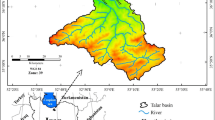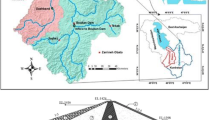Abstract
Flow conditions (flow discharge, flow depth, and flow velocity) in natural streams are mainly determined via the flow resistance formula such as Manning’s equation. Evaluating the accurate Manning’s roughness coefficient (n), especially in rivers with bed form during floods, to obtain more reliable results has always been of interest to scholars. The interaction between the flow and bed form is very complex since the flow conditions control bed forms, and vice versa. The main goal of the present study is to predict n in rivers with bed forms, using soft computing models, including multilayer perceptron artificial neural network (MLPNN), group method of data handling (GMDH), support vector machine (SVM) model, and genetic programming model (GP). To this end, the energy grade line (\({S}_{f}\)), flow Froude number (Fr), the relative submergence (\(y/{d}_{50}\); y = flow depth and d50 = bed sediment size), and the bed form dimensionless parameters (\(\Delta /{d}_{50}\), \(\Delta /\lambda\), and \(\Delta /y\); ∆ = bed form height and λ = bed form length) were used as the input variables, and n was used as the output variable. The results showed that all the test models have acceptable accuracy, while the SVM model showed the highest level of accuracy with the coefficient of determination \({R}^{2}=0.99\) in the verification stage. The sensitivity analysis of SVM and MLPNN models and the structural analysis of GMDH and GP models indicated that the most important parameters affecting n are Fr, \({S}_{f}\), and \(\Delta /\lambda\).










Similar content being viewed by others
Data Availability
The authors confirm that some data are available from the corresponding author on request.
Abbreviations
- A :
-
The corresponding coefficients (\(A=\left({a}_{1},{a}_{2}, \cdots {a}_{m}\right)\))
- \(\overline{{a }_{i}}\) :
-
The average of the Lagrange coefficients
- B :
-
The channel width
- b :
-
The constant in the regression function
- C :
-
A positive integer that determines the penalty when a model training error occurs
- \({d}_{50}\) :
-
The average diameter of sediment particles
- \(f\) :
-
The target function
- FFNN:
-
The feed-forward neural network model
- Fr :
-
The flow Froude number
- G :
-
Gravitational acceleration
- GMDH:
-
Group method of data handling
- GP:
-
Genetic programming model
- G s :
-
The relative density of sediment particles
- MAPE:
-
Mean absolute percentage error
- MLP-FFA:
-
Multilayer perceptron-firefly algorithm model
- MLPNN:
-
Multilayer perceptron artificial neural network
- N :
-
The number of samples (data used for training)
- \(n\) :
-
The total Manning roughness coefficient
- \(n''\) :
-
The bed form related to the Manning roughness coefficient
- \(O\) :
-
The observed value
- \(\overline{O }\) :
-
The mean observed value
- \(P\) :
-
The calculated value
- \(\overline{P }\) :
-
The mean calculated value
- R :
-
Correlation coefficient
- Re :
-
The flow Reynolds number
- RMSE:
-
Root mean square error
- R2 :
-
The coefficient of determination
- \({S}_{f}\) :
-
The energy grade line
- SI:
-
The scatter index
- SVM:
-
Support vector machine model
- V :
-
The average flow velocity
- \({W}^{T}\) :
-
The transpose of the coefficient matrix
- x :
-
The input variables (\(x=\left({x}_{1},{x}_{2}, \cdots {x}_{m}\right)\))
- \({X}_{j}\) :
-
The calculated value for the chromosome by fitting function \(j\)
- y :
-
The average flow depth
- \({Y}_{j}\) :
-
The measured value or the expected value of the chromosome by fitting \(j\)
- α :
-
The angle of the upstream side of the bed form relative to the horizon
- θ :
-
The angle of the downstream side of the bed form relative to the horizon
- λ :
-
The length of the bed form
- Δ :
-
The height of the bed form
- \(\varphi\) :
-
The kernel function
- \({\rho }_{s}\) :
-
The specific mass of sediment particles
- \({\rho }_{w}\) :
-
The specific mass of water
- \(\mu\) :
-
The dynamic viscosity of water
References
Afzalimehr H, Singh VP, Najafabadi EF (2010) Determination of form friction factor. J Hydrol Eng 15(3):237–243
Ayhan Ž (2011) A model of adaptive neural-based fuzzy inference system (ANFIS) for prediction of friction coefficient in open channel flow. Sci Res Essays 6(5):1020–1027
Azamathulla HM, Jarrett RD (2013) Use of gene-expression programming to estimate Manning’s roughness coefficient for high gradient streams. Water Resour Manage 27:715–729
Azamathulla HM, Haghiabi AH, Parsaie A (2016) Prediction of side weir discharge coefficient by support vector machine technique. Water Sci Technol Water Supply 16(4):1002–1016
BahramiYarahmadi M, ShafaiBejestan M (2011) Experimental study of the effect of sediment particles shape on Manning’s coefficient. J Water Soil 25(1):51–60
Brakenhoff L, Schrijvershof R, Van Der Werf J, Grasmeijer B, Ruessink G, Van Der Vegt M (2020) From ripples to large-scale sand transport: The effects of bedform-related roughness on hydrodynamics and sediment transport patterns in delft3d. J Mar Sci Eng 8(11):892
Chegini A, Pender G (2012) Determination of small size bed load sediment transport and its related bed form under different uniform flow conditions. WSEAS E-ISSN 8(4):158–167
Cortes C, Vapnik V (1995) Support-vector networks. Mach Learn 20(3):273–297
Dayhoff JE (1990) Neural network architectures: An introduction. Van Nostrand Reinhold Co
Dey S (2014) Fluvial hydrodynamics, vol 818. Springer
Dey S, Paul P, Fang H, Padhi E (2020) Hydrodynamics of flow over two-dimensional dunes. Phys Fluids 32(2):025106
Heydari M, BahramiYarahmadi M, ShafaiBejestan M (2022) Experimental study of the effect of bed forms on Darcy-Weisbach friction coefficient in straight open channels. J Hydraul 17(1):35–50
Ivakhnenko AG (1968) The group method of data handling, a rival of the method of stochastic approximation. Soviet Autom Control 13(3):43–55
Julien PY (2010) Erosion and sedimentation. Cambridge University Press
Kabiri F, Afzalimehr H, Smart G, Rousseau AN (2014) Flow over gravel dunes. Br J Appl Sci Technol 4(6):905–911
Koza JR (1992) Evolution of subsumption using genetic programming. Proceedings of the first European conference on artificial life. MIT Press, pp 110–119
Kwoll E, Venditti J, Bradley R, Winter C (2016) Flow structure and resistance over subaquaeous high-and low-angle dunes. J Geophys Res Earth Surf 121(3):545–564
Nasiri Dehsorkhi E, Afzalimehr H, Singh VP (2011) Effect of bed forms and vegetated banks on velocity distributions and turbulent flow structure. J Hydrol Eng 16(6):495–507
Niazkar M, Talebbeydokhti N, Afzali SH (2019) Novel grain and form roughness estimator scheme incorporating artificial intelligence models. Water Resour Manage 33:757–773
Okhravi S, Gohari S (2020) Form friction factor of armored riverbeds. Can J Civ Eng 47(11):1238–1248
Omid MH, Karbasi M, Farhoudi J (2010) Effects of bed-load movement on flow resistance over bed forms. Sadhana 35(6):681–691
Parsaie A, Haghiabi AH, Saneie M, Torabi H (2018) Prediction of energy dissipation of flow over stepped spillways using data-driven models. Iran J Sci Technol Trans Civ Eng 42(1):39–53
Roushangar K, Saghebian SM, Mouaze D (2017) Predicting characteristics of dune bedforms using PSO-LSSVM. Int J Sedim Res 32(4):515–526. https://doi.org/10.1016/j.ijsrc.2017.09.005
Roushangar K, Alami MT, Saghebian SM (2018) Modeling open channel flow resistance with dune bedform via heuristic and nonlinear approaches. J Hydroinf 20(2):356–375
Saberi-Movahed F, Najafzadeh M, Mehrpooya A (2020) Receiving more accurate predictions for longitudinal dispersion coefficients in water pipelines: Training group method of data handling using extreme learning machine conceptions. Water Resour Manage 34(2):529–561. https://doi.org/10.1007/s11269-019-02463-w
Saghebian SM, Roushangar K, OzgurKirca VS, Ghasempour R (2020) Modeling total resistance and form resistance of movable bed channels via experimental data and a kernel-based approach. J Hydroinf 22(3):528–540
Simons DB, Richardson EV, Albertson ML (1961) Flume studies using medium sand (0.45 mm). Colorado State University. Libraries
Simons DB, Richardson EV (1966) Resistance to flow in alluvial channels. US Government Printing Office
Singh B, Sihag P, Parsaie A, Angelaki A (2021) Comparative analysis of artificial intelligence techniques for the prediction of infiltration process. Geol Ecol Landscapes 5(2):109–118
Talebbeydokhti N, Hekmatzadeh A, Rakhshandehrou GR (2006) Experimental modeling of dune bed form in a sand-bed channel. Iran J Sci Technol Trans Civ Eng 30(4):503–516
Vanoni VA (2006) Sedimentation engineering. American Society of Civil Engineers
Vatanchi SM, Maghrebi MF (2019) Uncertainty in rating-curves due to Manning roughness coefficient. Water Resour Manage 33:5153–5167
Yao L, Peng Y, Yu X, Zhang Z, Luo S (2023) Optimal inversion of Manning’s roughness in unsteady open flow simulations using adaptive parallel Genetic algorithm. Water Resour Manage 37:879–897
Yuhong Z, Wenxin H (2009) Application of artificial neural network to predict the friction factor of open channel flow. Commun Nonlinear Sci Numer Simul 14(5):2373–2378
Zanganeh M, Rastegar A (2020) Estimation of roughness coefficient in erodible channels by ANNs and the ANFIS methods. Amirkabir J Civ Eng 52(2):495–512. https://doi.org/10.22060/ceej.2018.14532.5678
Acknowledgements
We are grateful to the Research Council of Shahid Chamran University of Ahvaz for financial support (SCU.WH1400.31373).
Funding
The funding of this research was provided by the Research Council of Shahid Chamran University of Ahvaz (Grant number: SCU.WH1400.31373).
Author information
Authors and Affiliations
Contributions
MBY, AP, MSB: Data Analysis, Supervision, Validation, Writing-Reviewing, and Editing. MH, MB: Conducting experiments and data collection.
Corresponding author
Ethics declarations
Ethics Approval
Not applicable.
Consent to Participate
Not applicable.
Consent to Publish
The authors declare their consent to the publication of the manuscript in “Water Resources Management” journal.
Competing Interests
The authors declare that they have no known competing financial interests or personal relationships.
Additional information
Publisher's Note
Springer Nature remains neutral with regard to jurisdictional claims in published maps and institutional affiliations.
Rights and permissions
Springer Nature or its licensor (e.g. a society or other partner) holds exclusive rights to this article under a publishing agreement with the author(s) or other rightsholder(s); author self-archiving of the accepted manuscript version of this article is solely governed by the terms of such publishing agreement and applicable law.
About this article
Cite this article
Yarahmadi, M.B., Parsaie, A., Shafai-Bejestan, M. et al. Estimation of Manning Roughness Coefficient in Alluvial Rivers with Bed Forms Using Soft Computing Models. Water Resour Manage 37, 3563–3584 (2023). https://doi.org/10.1007/s11269-023-03514-z
Received:
Accepted:
Published:
Issue Date:
DOI: https://doi.org/10.1007/s11269-023-03514-z




